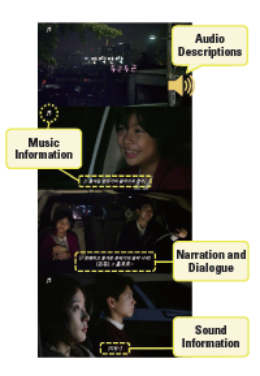Most people can easily enjoy various forms of cultural entertainment such as exhibitions and shows in their daily lives. It is, however, hard for those with visual and hearing impairments to enjoy such entertainment in the same way as others do. For them, even going to movie theaters, which is one of the easiest and most common hobbies among people, is a hard thing to do. This means that the visually and hearing impaired only have limited accessibility to cultural life unlike people without any impairments. To solve this problem, “barrier-free film” was created, but it is still unknown to most people. Therefore, the Sungkyun Times (SKT) now introduces what barrierfree film is, explains the necessity and reality of it, and looks at the efforts made in Korea to vitalize barrier-free film.
What Is Barrier-Free Film?

Definition of Barrier-free Film
A barrier-free film is one version of a movie made for those who cannot enjoy the visual and auditorial elements. It includes audio descriptions and subtitles. Audio descriptions help the viewers to know what is happening on the screen, and subtitles give information about narration, dialogue and sounds. The number of barrier-free films has been recently increasing at a steady pace as arguments regarding the rights to enjoy culture have started to include people with hearing and visual impairments as well. In Rochester in the United States, for example, a law was proposed obligating every movie to include audio descriptions and subtitles. In Korea, the first movie introducing audio descriptions and subtitles was shown at the “1st Persons with Disabilities Film Festival(PDFF)” in 2000. This was the forerunner for barrier-free film screenings of today.
Methods of Screening Barrier-free Film
There are two ways to screen barrier-free film: an open system and a closed one. In an open system, people in the same theater can watch movies with audio descriptions and subtitles simultaneously on the screen. This system is usually used on “Movie Day for People with Disabilities” in domestic multiplex cinemas. The level of completion of the movie is crucial in the open system because the movies are open to all to watch the movie. In a closed system, on the contrary, people can individually receive the barrier-free services via cell phone, frequency modulation (FM) radio with headphones, or other special devices if they want. In other words, the recipients can decide whether or not to get the service based on their intentions. It is, therefore, usually applied to those with visual impairments. Only a few theaters, however, are adopting the closed system at present. According to Kim Hee-min, an honorary ambassador of Seoul Barrier-free Film Festival (SeBaFF), there is almost no opportunity to watch barrier-free films in Korea, because of the low number of theaters preparing the closed system to screen various kinds of barrier-film movie.
Necessity and Reality of Barrier-free Film in Korea
Necessity for Barrier-free Film
Human beings are the only creatures able to enjoy culture and art, and this distinguishes them from other animals. Going to the theater is one of the ways to enjoy culture and art, but it is not that easy for those with visual and hearing impairments. Their accessibility to the movie theater and the movie itself is very poor. In Korea, there are several laws ensuring the rights of cultural enjoyment of people with disabilities like visual and hearing impairments, including in the Constitution and the Act for the Prohibition of Discrimination of Disabled Persons. Nevertheless, these laws have only abstract suggestions, so they cannot lead to any detailed solutions.
In this regard, Kim Soo-jeong, a representative of the Korean Barrierfree Films Committee (KOBAFF) said, “Failure to watch movies means that people with disabilities are excluded from cultural exchanges in society, so barrier-free film is a way to ensure the rights of them in the contemporary era.” According to the Ministry of Health and Welfare, 81.7% of the blind and 83.3% of the deaf could not watch any movies in 2014. As a result, some of them have even filed discrimination suits in order to be assured of their rights to enjoy cultural lives; for instance, a person with an impairment, who was unable to watch the movie Silenced which dealt with sexual assaults on children with disabilities, filed and won a law suit.
Reality of Barrier-free Film in Korea
① Difficulties in Making Barrier-free Film
First, only a few barrier-free films are produced every year. According to the KOBAFF, the number of barrier-free films made in 2017 was only 30, which was less than 7% of the total number of domestic movies released in the same year. The main reason behind this is the absence of legal compulsion to let barrier-free versions of the film to be made during the production process. In addition, financial burdens also have a huge influence. Because of the insufficient support from the government, barrier-free film is frequently produced through talent donations from celebrities. This can end up lowering the quality of the movie.
② Difficulties in Screening Barrier-free Film
Even if barrier-free films are produced, they are less likely to be screened in theaters because of the absence of legal obligation for theaters to screen them at a certain rate and for a certain period. Most of the domestic multiplexes set aside a day during the third week of the month as “Movie Day for People with Disabilities” for a one-shot event. Even though the day is to encourage those with impairments to watch movies, most barrier-free films are only screened when there are few visitors such as in the morning. Furthermore, the number of theaters screening the films is limited. According to the Korea Association of the Deaf, a barrier-free version of the movie Along with the Gods: The Two Worlds was released on January 16th, a month after the release date of the original version. It was, however, screened only once a day for 10 days nationwide.
Efforts to Activate Barrier-free Film in Korea
Legislation of Mandatory Law to Obligate Producing and Screening of Barrier-free Film
Legislation of a mandatory law is required to increase the production and screening rates of barrier-free film. If the legislation is passed, every film company must prepare a barrier-free version of a movie at the same time as the original film is produced. This would prevent the cases where only a few barrier-free versions of movies get released. For instance, Disney introduced an application “Disney Movies Anywhere” in 2014, which made it possible for viewers to get immediate audio descriptions on the screen. Movie theaters should also provide information about through which system they screen barrier-free films and equipment available to the audience. Indeed, Regal, the American movie theater chain, informs on their website whether or not the audience can rent devices for audio descriptions and subtitles during the screening. Similarly, the National Assembly of the Republic of Korea is also discussing the amendment of Enforcement Decree of the
Promotion of the Motion Pictures Industry Act. According to the amendment, theaters should provide their audience with devices for enjoying barrier-free movies.
Activating Barrier-free Film Festival

The barrier-free film festival is another effective method for vitalizing barrier-free film. The festival can encourage people to pay attention to barrier-free films which are still rarely found in theaters. In Korea, various programs are held at the annual barrierfilm festival called SeBaFF. The most representative program, for example, is screening movies with live audio descriptions where one can directly read audio descriptions live as a film being played. Through the programs, every spectator can get to know what barrier-free film is. In other words, the festival not only provides an opportunity to watch barrier-free film, but also contributes to its popularization by conducting f o r u m s a n d a u d i e n c e participation events.
Some people may consider that movies are just trivial things, arguing that they have to focus more on wider culture. It is, however, never a trivial thing. Although a lot of people without disabilities often say their hobby is watching movies, it is hard for the visually and hearing impaired to watch even one film in the movie theater. Equality does not start from something special, but usually comes from things around What Barrier-free Film Looks Like us. Barrier-free film is a starting point of making an equal society, so society should pay attention to it more right now.
